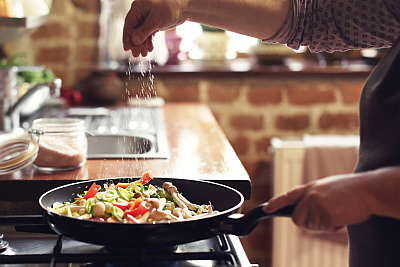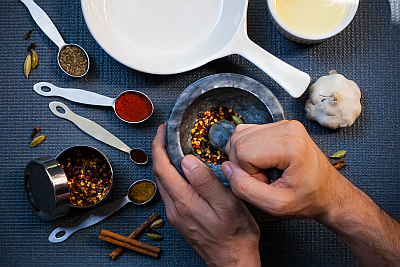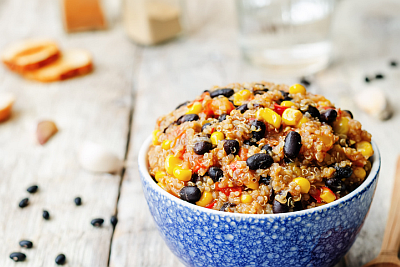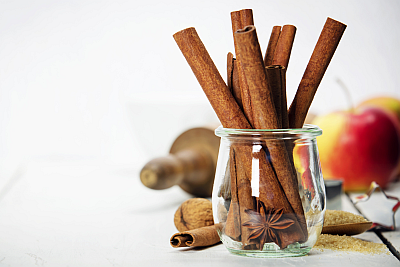A dash here, a shake or two there. For most of us, salt is a common, everyday cooking ingredient. It can be found in the items we buy and in the recipes we love. That’s because salt makes food taste good and, as humans, we’re actually wired to like it.
In moderation, that’s perfectly all right—salt contains the nutrient sodium, which our bodies need to maintain a proper balance of water and minerals, among other things. But as many of us have heard, too much can be bad news for your health.“That’s why we at Aramark have teamed up with the American Heart Association to decrease the amount of sodium in the food we serve, as part of our Healthy for Life initiative,” “To date, we’ve reduced sodium by 14 percent on key menus—well on our way to our goal of achieving 20 percent by the end of 2020.”
There are steps you can take to decrease your salt intake, too! With her experience in finding healthier ways to deliver great flavor, Laura turned out to be the perfect person to continue our sodium conversation. Here she shares some “spicy” tips and tricks for cooking with less salt.
What’s the difference between a spice and an herb?
“Spices can come from the bark, root, stem or seed of the tree or plant,” Richardson explains. “Examples include black pepper, ginger, turmeric, and cinnamon. Herbs are the green, leafy part of the plant, such as basil, sage, thyme, and oregano.”
When purchasing containers of spices, you should read the ingredient list, Richardson advises. “Some spices in powder form, such as garlic and onion spices, typically don’t include salt. But garlic salt and onion salt do. Even some brands of lemon pepper.”
Richardson’s general tips:
- If you’re missing the taste of salt, flavorings like black pepper, garlic powder, cumin, mint, dill, crushed red pepper, basil and onion are effective as a replacement.
- Blooming spices in a fat is an Asian cooking technique. Adding a fragrant spice like red pepper flakes or rosemary to a small amount of oil and heating it up can release the full potential of the spice to really elevate the flavor profile of your dish.
- You can mix fresh herbs into your food once it is cooked. This adds flavor and texture, and the colors really dress up the meals.
- At times a dish may taste too fatty, but adding an acid such as lemon, lime or orange juice can not only cut through the fat but also give it a new level of flavoring.
- Herb-infused oils are a real treat and can be drizzled on meats, vegetables or breads.
- All vinegars (red wine, white, balsamic, apple cider, rice) can be used as marinades or drizzles for many types of dishes.
- Honey, jams and preserves are excellent replacements when glazing meats or dressing up starches.
Cooking techniques that build flavor with aromatic vegetables
Mirepoix – French
This sautéed mixture of diced vegetables cooked in butter is named after a French aristocrat in the 18th century. Mirepoix is a staple in French cuisine.
- 2 parts onion, 1 part celery, 1 part carrot
- Dicing vegetables and cooking in butter
Soffritto (Holy Trinity) Italian Cooking Base
This mixture of roughly chopped and slowly cooked onion, celery and carrots in olive oil is referred to as the “Holy Trinity” of Italian cooking. The key is to heat the mix slowly for 30 to 60 minutes. This is a staple in sauces and soups.
- Onion, celery, carrot (could also contain garlic, parsley, etc.)
- Vegetables are roughly chopped into small pieces
- Slowly cooked in olive oil over low heat for 30 minutes to an hour
Holy Trinity for Cajun and Creole
Jambalaya and gumbo both start from this base of onion, celery and bell peppers cooked in butter or olive oil. A variation of Mirepoix, this is the base for several dishes in Cajun and Louisiana Creole cuisine.
- Equal parts onion, celery, bell peppers
- Cooked in olive oil or butter
Sofrito (Latin)
This mixture of onion, bell peppers, garlic and tomatoes cooked in olive oil is a staple in Latin American cuisine. A flavor base for soups, paella, sauces and stews.
- Onion, bell peppers, garlic, tomatoes
- Cooked in olive oil
- Common in paella and stews
Flavoring ideas for different food categories
- Poultry: Parika, lemon juice and black pepper, parsley, oregano, sage, rosemary
- Beef: Thyme, sage, rosemary, pepper, onion, dry mustard, garlic
- Fish: Lemon juice, dill, onion, paprika, parsley, cumin, horseradish, basil, tomato, pepper
- Pork: Allspice, cinnamon, applesauce, sage, ginger, garlic, cloves
- Vegetables: Rosemary, sage, curry, dill, garlic, onion, chives, oregano, basil, parsley
The idea is nothing new: We have been cooking with spices and dried herbs for centuries. But today many people don’t understand how to use them. “It’s easy to get hung up on pairing herbs and spices with the right foods, and combining them in the right quantities,”
Whether you’re making a marinade or a dry rub, mixing ingredients will yield deep, satisfying flavor. That’s why your first step is to start with a well-stocked pantry. With the right jars at your fingertips, you can add flavor to anything—from chicken to popcorn to fresh produce—without having to reach for the salt shaker. (Bonus: Pure herbs and spices are sodium-free and essentially calorie-free, which means you can use as much as you want!)
stocking up on these basics:
| Spices | Herbs |
| Chili Powder Cloves Coriander Cumin Garlic Powder Mustard Powder Nutmeg Onion Powder Paprika Turmeric |
Basil Chives Dill Lemongrass Mint Oregano Parsley Rosemary Sage Tarragon |
BLEND FOR A BOOST
Spend a little more time in the spice aisle, and you’ll notice an array of spice and herb “blends.” Sounds like the perfect shortcut, right? Not so fast, “While convenient, these products can sometimes have salt as a leading ingredient. Check the nutrition label to be sure you’re getting the herb or spice you’re looking for, without the salt.”
Better yet, make your own blend at home (here’s a great no-salt blend to try)! “The great thing about this is you can include what you love and skip what you don’t,” “And you always know how fresh it is.”
Don’t be afraid to get creative here. Test some unexpected pairings. If you love the individual flavors, they probably are even better together. Each member of the family can have his or her own shaker at the ready. Adjust your signature blends over time, tinkering with ingredients and amounts.
Still can’t live without your trusty store-bought taco or BBQ seasoning? “See if it comes in a lower-sodium version,” “You may not even taste the difference.”

Get Recipe: No-Salt Spice Blend
GO GLOBAL
If you need more inspiration, look no further than your favorite cuisines. “The notes from spices and herbs are what distinguish one culture’s cuisine from another,” “Think about those familiar aromas—you can recognize them before you even take your first bite.”
Here is her cheat sheet for many common flavor profiles, plus some recipes that put them to good use:
Indian: Cumin, coriander, cinnamon, turmeric, ginger, mustard powder, and chili powder make the perfect blend. Try: Tandoori Chicken Wrap or Chicken & Chickpea Shawarma for warm, savory flavor.
Italian: Pick up some garlic powder, onion powder, basil, rosemary, thyme, and oregano. Try: Our Spicy Shrimp and Penne or Grilled Veggie Pizza—sure to bring the Italian zest you’re looking for.
Mexican: Cue the cumin, garlic powder, and oregano. Craving some heat? Kick things up a notch with chili powder. Try: Mexican Street Corn Salad or Corn & Quinoa Salad.
 Get Recipe: Corn and Quinoa Salad
Get Recipe: Corn and Quinoa Salad
FLAVOR AS A FAMILY
favorite things about testing out new spice pairings is having her three-year-old son serve as sous chef!
“He loves to be in the kitchen with me, and this is a safe task for him at this age,” “He can dump, mix, and pour ingredients into smaller storage containers. We have a great time together, and I know I’m teaching him to enjoy cooking with a wide range of flavors.”
Remember those signature blends? Add a dose of fun by letting your kids name their special mix. Get your hands on some blank labels and see what they come up with. (Green Unicorn Pixie Dust? Sounds delish!)

A SALTY SITUATION
It’s okay to sprinkle on the salt or pick up your go-to salty (and sometimes pre-packaged) treat from time to time. But you can keep your overall sodium intake in check by also leaning on the vibrant taste of herbs and spices.
“Think of it as expanding your culinary-range in the kitchen,” “You’ll naturally use less salt as a result. Over time, your taste buds may even change and you’ll come to prefer less salt.”




